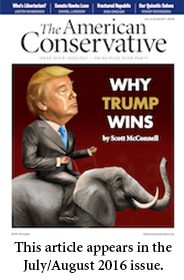Unnatural Monopolies

When Lord Acton warned about the corrupting tendency of power, he wasn’t thinking of electricity. The British statesman nonetheless wouldn’t have been surprised by the case of Michael Peevey, former president of the California Public Utilities Commission, which regulates electric utilities in the state.
In 2013, Peevey held secret meetings—in a hotel in Warsaw, Poland, no less—with representatives of Southern California Edison. In their discussions, he allegedly agreed to have ratepayers cover more than $3 billion in costs related to closing one of Edison’s nuclear facilities. The scheme was discovered when a raid on Peevey’s house turned up notes from the meetings written on the hotel’s stationery. Peevey was forced to resign his post and was subject to multiple criminal investigations.
While eye-catching, the Peevey affair is just one extreme example of a broader phenomenon. All across America, incentives for collusion between electric utilities and the agencies set up to oversee them are built into the regulatory system itself, which operates on an assumption that utilities are “natural monopolies.” This is crony capitalism at its most flagrant. But what’s the alternative?
As it happens, Texas and a handful of other states have discovered one, by introducing new regulatory schemes that force utilities to compete with each other. The results so far are encouraging—especially compared with the sordid situation that prevails elsewhere in the country.
♦♦♦
Historically, regulation of natural monopolies has followed the old Mark Twain adage: put all of your eggs in one basket and then watch that basket. Under this model, a single utility provides services to people in a given area, and nearly every aspect of its operations is subject to government oversight. Utilities are allowed to charge rates based on their costs, plus a set rate of return on their assets as deemed appropriate by a state public utilities commission (PUC).
In such a system, effective regulation requires full information about the resources in question and an independent, uncompromised regulator. In practice, however, regulators often find themselves dependent on the utilities for knowledge and expertise about the matters they are regulating, and the men and women behind the regulations are subject to a variety of political influences. The result is “regulatory capture”—the enrichment of businesses through regulations geared toward their benefit, not taxpayers’. And regrettably, unlike what’s alleged in the Peevey case, most regulatory capture is legal and routine.
Consider the problem of expertise. Relying on the expertise of the electric utilities is, in one sense, perfectly natural. But it creates opportunities for utilities to shade regulations in their favor. Earlier this year in Nevada, for example, the PUC relied on NV Energy—the state monopoly—to supply an analysis that would be used in determining the compensation to be paid to the owners of rooftop solar panels for the electricity they provide to the shared grid. NV Energy claimed it could not set a value on all the potential benefits of rooftop solar, however, so the utility simply declined to price them in—thus sparing the company from having to pay out for solar contributions to the state’s power system. An appropriate value analysis would have produced substantially different results, but the utility had no incentive to provide one.
Contrary to good-government myths of disinterested administration, regulatory decisions are inherently political: they involve winners and losers, and utilities are highly motivated to place themselves in the former category. The pressures they bring to bear on PUCs are often subtle and act through a convoluted network of influence. Even where regulators aren’t dependent on the expertise of the companies they oversee, political factors push them in the utilities’ desired direction.
The influence is most evident in big decisions such as rate cases, mergers, and project approvals. A favorable regulatory ruling can mean billions for a utility—at the expense of ratepayers, whose individual pain is too widely dispersed to spark organized opposition. And while consumer-advocacy organizations do exist, utilities have far deeper pockets. They can afford the best consultants to testify in cases on their behalf. They also employ their ample resources to back interest groups that agree with them on whatever issue is at hand, fostering the impression that their position is supported by a broad range of public groups.
The political sway often starts with the governor in states where commissioners are appointed. The all-too-common appointment of unqualified candidates, many of whom lack any regulatory or energy experience, illustrates power companies’ and officeholders’ shared desire for political conduits, not independent leaders. Smart regulators in turn look to their own financial futures. Seeking to cash in after leaving office, state commissioners have good reason to cooperate with the utilities they oversee in the meantime. Ethics rules generally require “cooling off” periods after public service, prohibit commissioners from holding personal financial stakes in regulated entities, and impose other restrictions to reduce the incentives for collusion. But all this only slows the revolving door.
The role of regulation in utility monopolies has frequently led to decisions that make little sense from the perspective of the public interest. Regulatory encouragement led to excessive build-outs of new power generation in the 1970s and 1980s that cost ratepayers billions. Remnants of this excess persist in the South and Great Plains, where power systems remain oversupplied. The same faulty incentives have led to chronic underinvestment by utilities in energy efficiency. The natural-monopoly regulatory model has also proven slow to respond to disruptive market developments, such as the advent of cheap natural gas. The whole system looks more like 20th-century socialism than like the 21st-century innovation economy.
All this has its roots in a single bad idea. The notion that utilities are natural monopolies means that service has to come from a single provider, which is legally required to serve consumers at the lowest feasible cost—determined, as so often happens, by regulators beholden to the industry itself. But do utilities really need to be monopolies?
The experience of Texas suggests they don’t.
♦♦♦
Whatever the merits of treating electricity as a natural monopoly in the past, jurisdictions like Texas have shown that model is, at best, no longer necessary. Since 2002, Texas has operated under a “restructured” electrical market, with competition for electricity generation and in wholesale and retail markets throughout most of the state. Today, 85 percent of Texas power customers can pick their electric provider—the way consumers elsewhere can pick their phone or cable companies—while decisions about generation mix and rates are made based on competitive market forces, rather than political haggling.
Earlier attempts at restructuring or “deregulation” in Texas had been stymied by utility opposition. But proponents eventually were able to put together a coalition of business interests and others who expected to benefit from lower prices under competition. Texas was also helped by the fact that it maintains its own intrastate electric grid, which frees it from some federal regulation.
The Texas experience with utility competition has been positive. Texans who want to look for the best energy deal can go to PowerToChoose.org to compare rates and terms from providers in their area. Given the option to choose their electricity company, nearly half of Texans—and 85 percent of Texan businesses—have opted to go with a competitor to the incumbent utility.
The result? Between 2010 and 2015, electric rates were 12 percent below the national average. On the generation side, the Texas grid maintains a mix of gas, coal, nuclear, and wind energy, thereby maintaining reliability and avoiding brownouts and blackouts. The independent market monitor for the Texas grid has found that its market has performed in an efficient, competitive fashion.
Deregulating energy markets has not always gone smoothly. Early in the restructuring process, poor transitional policies caused price spikes in some states. The Enron debacle in 2001 sent shockwaves that undermined confidence in competitive electricity markets. These developments stalled momentum for restructuring, even leading some critics to contend that “competition works everywhere, except electricity.” More than a decade later, however, market-rule fixes have ensured that manipulation on the scale of Enron can never occur again. Meanwhile, competitive electricity markets have evolved to become superior alternatives to monopoly regulation.
Competition encourages power companies to reduce costs, unlike the regulatory model. This has resulted in major innovations, such as improved efficiency in natural-gas power plants and the ability to utilize nuclear plants more effectively. The regulatory model, by contrast, does not reward innovation, often handcuffing utilities that want to innovate.
Texas and other competitive states are realizing the benefits of cheap natural gas much more than regulated states. Over the past decade, the price of natural gas has fallen sharply from nearly $7 per million BTUs to just over $2 today. Competitive markets have responded swiftly, investing heavily in natural-gas plants and shutting down power plants that are no longer profitable in the cheap-gas era. This has lowered power prices considerably in restructured states, while regulated states have been slow to transition.
 Cheap gas should be good news for consumers, but it’s not so great for companies that are heavily invested in more expensive existing power plants. In Ohio, for example, American Electric Power Ohio and First Energy Corporation worked out a deal with state regulators to force customers to buy power from coal and nuclear plants, despite the availability of cheaper power made possible by low gas prices. Under the commission’s logic, however, it was better to buy expensive electricity now, rather than risk having to do the same thing later if gas prices went back up. This mandated insurance plan will likely cost Ohioans billions over the next decade.
Cheap gas should be good news for consumers, but it’s not so great for companies that are heavily invested in more expensive existing power plants. In Ohio, for example, American Electric Power Ohio and First Energy Corporation worked out a deal with state regulators to force customers to buy power from coal and nuclear plants, despite the availability of cheaper power made possible by low gas prices. Under the commission’s logic, however, it was better to buy expensive electricity now, rather than risk having to do the same thing later if gas prices went back up. This mandated insurance plan will likely cost Ohioans billions over the next decade.
Similarly, in April, Oklahoma’s PUC approved a $500 million expense to put pollution controls on an old, inefficient coal plant. Justifying the measure, Commissioner Dana Murphy said Oklahoma didn’t want to fall into the “trap” of excess dependence on gas, particularly since natural gas “is subject to market forces.” But even if gas prices were to rise considerably, alternatives—such as buying power from excess supply elsewhere in the region—would be more cost-effective. Competitive electricity suppliers, unlike politically chosen regulators, follow market signals in response to cheap gas in a cost-effective way. Consumers reap the rewards.
Consumer choice, greater efficiency, responsiveness to market signals—these are all made possible by deregulation and competition on the Texas model. Yet bringing further competition to the way electricity is provided in the United States won’t be easy, without a fresh push on the part of businesses and other consumers to restart momentum toward restructuring. The more successful examples of electrical competition there are, the more the case for the status quo will be undermined. And alongside the virtues of increased innovation and customer choice, such competition offers by far the best remedy to deter cronyism.
Josiah Neeley is Texas director for the R Street Institute. Devin Hartman is electricity policy manager for the R Street Institute.